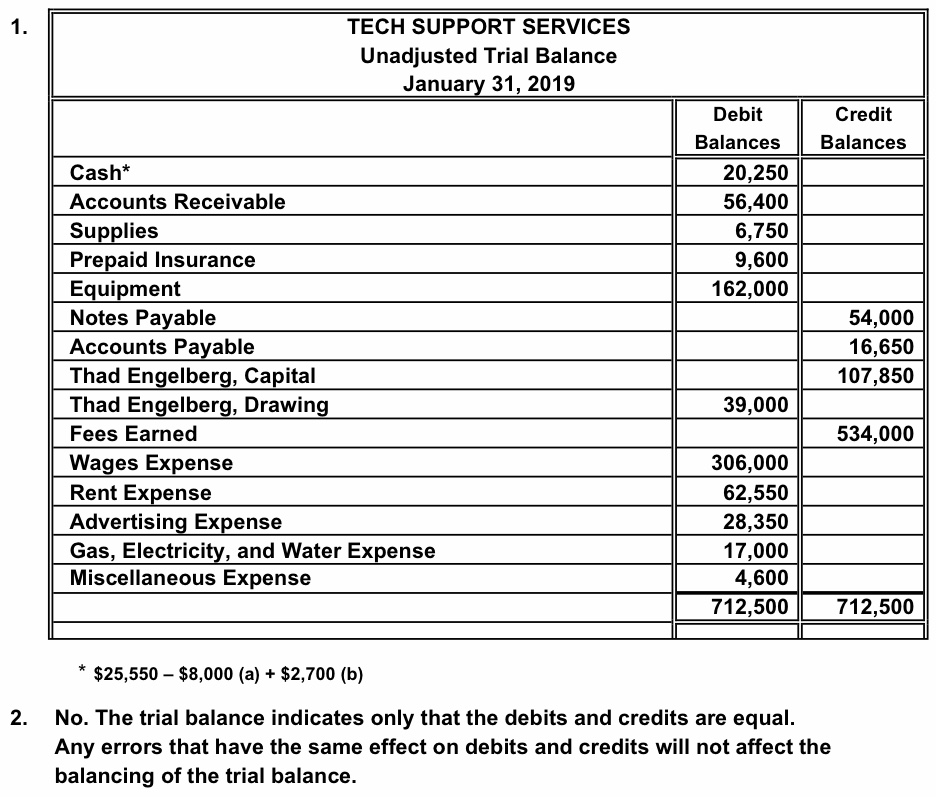
You can now compare your 1st column with the last period’s closing balances or the 1st day of this period’s balances to ensure accuracy. This makes it easier to prepare financial statements since they will contain one less step. This report captures what the business owns and owes without any adjustments for revenue earned but not yet received or expenses incurred but not yet paid. Tax accountants and auditors also use this report to prepare tax returns and begin the audit process. This will ensure all revenues, expenses, gains, and losses are accounted for. Shaun Conrad is a Certified Public Accountant and CPA exam expert with a passion for teaching.
Would you prefer to work with a financial professional remotely or in-person?
Whereas, the adjusted trial balance (ATB) is the same as UTB except that it also includes any adjusting entries made during an accounting period. Managers and accountants can use this trial balance to easily assess accounts that must be adjusted or changed before the financial statements are prepared. There’s also a chance it’ll fail to flag entries incorrectly coded to the wrong accounts, which can ultimately lead to inaccurate financial statements. A trial balance plays a major role in the accounting cycle, notably at the end of an accounting period before generating financial statements. It is important to note that the unadjusted trial balance is prepared in traditional bookkeeping.
Steps To Follow
Unadjusted trial balance numbers are simply the account balances from the general ledger. Once all balances are transferred to the unadjusted trial balance, we will sum each of the debit and credit columns. The debit and credit columns both total $34,000, which means they are equal and in balance. However, just because the column totals are equal and in balance, we are still not guaranteed that a mistake is not present. A balanced trial balance hints at no apparent accounting error, whereas discrepancies imply an error somewhere in the account balances.

What is an unadjusted trial balance in accounting?
To embark on the preparation of an unadjusted trial balance, one must meticulously gather and synthesize data from the general ledger—a foundational step that sets the stage for accurate financial reporting. The unadjusted trial balance takes center stage before year-end adjustments enter the picture. It lays out raw financial data straight from the accounting records, serving as evidence of all monetary transactions up until that moment. Moving from the broad concepts of accounting, let’s focus on the unadjusted trial balance. It lists every general ledger account along with its respective balance at a particular time.
- Once all balances are transferred to the unadjusted trial balance, we will sum each of the debit and credit columns.
- In an alternative format, the unadjusted trial balance may have a separate column for all debit balances and a separate column for all credit balances.
- In the end, making sure you have a UTB to compare with your ATB is important because it will ensure that all accounts in your organization are accurate and complete.
- These adjusted account balances are then used to create the year-end financial statements.
- Step by step procedure for preparing an unadjusted trial balance is as follows.
- A trial balance ensures the accuracy of your accounting system and is just one of the many steps in the accounting cycle.
Submit to get your retirement-readiness report.
Our team of reviewers are established professionals with decades of experience in areas of personal finance and hold many advanced degrees and certifications. For information pertaining to the registration status of 11 Financial, please contact the state securities regulators for those states in which 11 Financial maintains a registration filing.
Can I tell if my business is profitable just by looking at the unadjusted trial balance?
While the former is about noting down the transactions roughly, the latter is the means of presenting data in proper order. Once you have entered all of your transactions for this accounting period, the 1st and 2nd columns of UBTB will contain the opening and closing balances for each account. Note that while a trial balance is helpful in the double-entry system as an initial check of account balances, it won’t catch every accounting error.
The accountant will need to trace and find the discrepancy to ensure the debits and credits are equal. First, the account balances from the general ledger and subsidiary irs still working on last year’s tax returns may extend 2021 tax deadline ledgers are transferred to a trial balance. Next, these balances are listed in balance sheet and income statement order with their debit and credit balances.
If the final balance in the ledger account (T-account) is a debit balance, you will record the total in the left column of the trial balance. If the final balance in the ledger account (T-account) is a credit balance, you will record the total in the right column. It will allow you to spot-check the accuracy of the first step in preparing your company’s financial statements – that is, entering balances from your account ledger into a spreadsheet.
It’s like a health check for your accounts before you make any changes. With this tool, we can spot mistakes early and ensure every transaction is in the right place. Accountants call this process ‘balancing the accounts.’ It shows if total debits equal total credits as they should. Accountants look at the unadjusted trial balance to check the account balances.